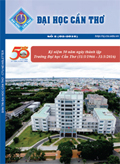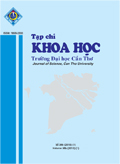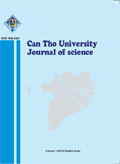Thông tin chung: Ngày nhận bài: 21/05/2018
Ngày nhận bài sửa: 24/07/2018 Ngày duyệt đăng: 03/08/2018 Title: Isolation of Clostridium botulinum and determination of botulin toxin from limberneck-ducks in the Mekong Delta Từ khóa: Clostridium botulinum, botulin, đồng bằng sông Cửu Long, vịt lệt mềm cổ Keywords: Botulin, Clostridium botulinum, limberneck, Mekong Delta | ABSTRACT Specimen samples from 100 limberneck ducks (including: 80 serum samples, 100 gut content samples and 100 liver samples) were collected in some districts of Can Tho city and Kien Giang province, from May 2016 to April 2017. Gut content samples and liver samples were used for isolation of Clostridium botulinum by culturing on Cooked –Meat medium and blood agar, then PCR tests were used to identify Clostridium botulinum type (Miia Lindstrom and Hannu Korkeala, 2001; Amit-Romach et al., 2004). Serum samples were used for detecting botulin (toxin of Clostridium botulinum) by mouse lethality assay as the description of CDC (1998). The result of isolation showed that 21% (42/200) samples were possitive to Clostridium spp. Results of typing by PCR method showed that Clostridium botulinum type C, type D and type E made up 2.38% (1/42), 9.52% (4/42), 9.52% (4/42), respectively. The results of botulin toxin determination revealed that 49/80 sera (61.25%) without the heat treatment caused the death of mice, while the heat treatment sera did not cause mice death. The result of the determination of toxin type, the rate of toxin type C was 61,23%, followed by type D (32.65%), and type E (6.12%). The result showed that Clostridium botulinum type C, D, E was the main causes of limberneck duck disease in Can Tho city and Kien Giang province. TÓM TẮT 100 mẫu từ 100 con vịt bị liệt mềm cổ (gồm 80 mẫu huyết thanh, 100 mẫu dịch ruột và 100 mẫu gan) được thu thập tại một số huyện thuộc thành phố Cần Thơ và tỉnh Kiên Giang từ tháng 05 năm 2016 đến tháng 04 năm 2017. Mẫu dịch ruột và gan được ủ trong môi trường Cooked Meat, môi trường thạch máu và kiểm tra đặc tính sinh hóa bằng phương pháp nhuộm Gram kết hợp với kỹ thuật PCR của Lindstrom and Hannu Korkeala, (2001) và Amit-Romach et al. (2004) để phân lập vi khuẩn Clostridium botulinum. Các mẫu huyết thanh được tiến hành thử độc tố botulin của vi khuẩn Clostridium botulinum bằng phương pháp thử nghiệm gây chết chuột bạch theo mô tả của CDC (1998). Kết quả phân lập cho thấy vi khuẩn Clostridium spp. trên mẫu ruột và gan vịt có triệu chứng liệt mềm cổ là 21% (42/200), trong đó vi khuẩn Clostridium botulinum trên các mẫu gồm 1 mẫu type C (2,38%); 4 mẫu type D (9,52%) và 4 mẫu type E (9,52%). Kết quả xác định type độc tố botulin bằng thử nghiệm trên chuột cho thấy có 49/80 mẫu bệnh phẩm huyết thanh không xử lý nhiệt đã gây chết chuột, chiếm tỷ lệ 61,25%, trong khi tất cả mẫu huyết thanh đã xử lý nhiệt đều không gây chết chuột thí nghiệm. Kết quả định type độc tố cho thấy, tỷ lệ xuất hiện độc tố type C là 61.23% (30/49), type D là 32,65% (16/49), và type E là 6,12% (3/49). Độc tố type C, D của vi khuẩn Clostridium botulinum là một trong những nguyên nhân gây bệnh liệt mềm cổ trên vịt ở một số địa phương thuộc thành phố Cần Thơ và tỉnh kiên Giang. |






